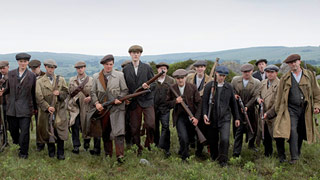It is refreshing to see a Latin American perspective on a Latin American problem. Before watching Secuestro Express, the only film I had seen that dealt with Latin America’s rampant kidnapping epidemic was the American film Man on Fire (Tony Scott, 2004), which is technically in Central America anyway and ultimately becomes more of a revenge-quest film that doesn’t shed much light on the social conditions that have led up to this criminal trend. Contrastingly, Secuestro is fully intent on showing us the entire kidnapping ritual, from victim-selection to eventual release; if still alive that is.
Set in Caracas, the film details the express-kidnapping (a fast-moving form of kidnapping which aims to go from victim-abduction to ransom-payment in 3 to 4 hours) of Carla (Mia Maestro) and Martin (Jean Paul Leroux), a young and wealthy party-couple who get singled-out as perfect victims because they own a brand-new SUV. As the film frantically progresses, we witness the calls to the victims’ fathers, drug pit-stops, universally corrupt authorities and the eventual execution of one of the victims seen through his/her POV. During various conversations between abductors and abductees, economic inequalities are discussed and blamed for the victims’ ordeal.
Aesthetically, Secuestro initially resembles that of Man on Fire. While it is shot on digital video, the hand-held shakiness, coupled with the extensive use of wide-angle lenses and quick sweeping movements, gives the film a sense of distorted realism, which is rendered chaotic due to its fast editing pace. This latter characteristic is largely responsible for the film’s seemingly incessant motion, the speed of which hardly ever lets off, even when stuck in a car for 10 minutes; as is the case during the first stage of the kidnapping. Numerous shots taken from inside the vehicle quickly cut over one another, accentuating the claustrophobic yet energy-filled nature of the confined interior. Noteworthy of these includes a shot taken from the floor of the SUV, looking up at the male victim’s face pressed up against it, his captors hovering over him in the background. The film’s rapid shot-succession interestingly makes its long takes more appreciated and noticeable, as they give the viewer a well-deserved breather, including one motionless shot when the gang discovers their car’s been stolen; and perhaps the most impressive shot of the whole film when Carla’s father (Ruben Blades) delivers the ransom money, the camera following him into a daycare, rising up as he goes down the stairs, becoming smaller as the camera pulls back to watch him disappear.
While its aestheticized violence is at times reminiscent of the Brazilian film City of God (Fernando Mireilles, 2002), it presents a much less polished vision of rampant crime, emphasizing the low-priced prevalence of drugs and its link to police corruption as a major factor in eliminating any chance the vicitms may have of being rescued.





























